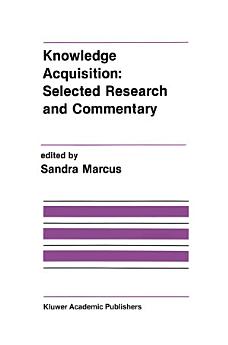Knowledge Acquisition: Selected Research and Commentary: A Special Issue of Machine Learning on Knowledge Acquisition
Sandra Marcus
ਦਸੰ 2012 · Springer Science & Business Media
4.0star
2 ਸਮੀਖਿਆਵਾਂreport
ਈ-ਕਿਤਾਬ
152
ਪੰਨੇ
reportਰੇਟਿੰਗਾਂ ਅਤੇ ਸਮੀਖਿਆਵਾਂ ਦੀ ਪੁਸ਼ਟੀ ਨਹੀਂ ਕੀਤੀ ਗਈ ਹੈ ਹੋਰ ਜਾਣੋ
ਇਸ ਈ-ਕਿਤਾਬ ਬਾਰੇ
What follows is a sampler of work in knowledge acquisition. It comprises three technical papers and six guest editorials. The technical papers give an in-depth look at some of the important issues and current approaches in knowledge acquisition. The editorials were pro duced by authors who were basically invited to sound off. I've tried to group and order the contributions somewhat coherently. The following annotations emphasize the connections among the separate pieces. Buchanan's editorial starts on the theme of "Can machine learning offer anything to expert systems?" He emphasizes the practical goals of knowledge acquisition and the challenge of aiming for them. Lenat's editorial briefly describes experience in the development of CYC that straddles both fields. He outlines a two-phase development that relies on an engineering approach early on and aims for a crossover to more automated techniques as the size of the knowledge base increases. Bareiss, Porter, and Murray give the first technical paper. It comes from a laboratory of machine learning researchers who have taken an interest in supporting the development of knowledge bases, with an emphasis on how development changes with the growth of the knowledge base. The paper describes two systems. The first, Protos, adjusts the training it expects and the assistance it provides as its knowledge grows. The second, KI, is a system that helps integrate knowledge into an already very large knowledge base.
ਰੇਟਿੰਗਾਂ ਅਤੇ ਸਮੀਖਿਆਵਾਂ
4.0
2 ਸਮੀਖਿਆਵਾਂ
ਇਸ ਈ-ਕਿਤਾਬ ਨੂੰ ਰੇਟ ਕਰੋ
ਆਪਣੇ ਵਿਚਾਰ ਦੱਸੋ
ਪੜ੍ਹਨ ਸੰਬੰਧੀ ਜਾਣਕਾਰੀ
ਸਮਾਰਟਫ਼ੋਨ ਅਤੇ ਟੈਬਲੈੱਟ
Google Play Books ਐਪ ਨੂੰ Android ਅਤੇ iPad/iPhone ਲਈ ਸਥਾਪਤ ਕਰੋ। ਇਹ ਤੁਹਾਡੇ ਖਾਤੇ ਨਾਲ ਸਵੈਚਲਿਤ ਤੌਰ 'ਤੇ ਸਿੰਕ ਕਰਦੀ ਹੈ ਅਤੇ ਤੁਹਾਨੂੰ ਕਿਤੋਂ ਵੀ ਆਨਲਾਈਨ ਜਾਂ ਆਫ਼ਲਾਈਨ ਪੜ੍ਹਨ ਦਿੰਦੀ ਹੈ।
ਲੈਪਟਾਪ ਅਤੇ ਕੰਪਿਊਟਰ
ਤੁਸੀਂ ਆਪਣੇ ਕੰਪਿਊਟਰ ਦਾ ਵੈੱਬ ਬ੍ਰਾਊਜ਼ਰ ਵਰਤਦੇ ਹੋਏ Google Play 'ਤੇ ਖਰੀਦੀਆਂ ਗਈਆਂ ਆਡੀਓ-ਕਿਤਾਬਾਂ ਸੁਣ ਸਕਦੇ ਹੋ।
eReaders ਅਤੇ ਹੋਰ ਡੀਵਾਈਸਾਂ
e-ink ਡੀਵਾਈਸਾਂ 'ਤੇ ਪੜ੍ਹਨ ਲਈ ਜਿਵੇਂ Kobo eReaders, ਤੁਹਾਨੂੰ ਫ਼ਾਈਲ ਡਾਊਨਲੋਡ ਕਰਨ ਅਤੇ ਇਸਨੂੰ ਆਪਣੇ ਡੀਵਾਈਸ 'ਤੇ ਟ੍ਰਾਂਸਫਰ ਕਰਨ ਦੀ ਲੋੜ ਹੋਵੇਗੀ। ਸਮਰਥਿਤ eReaders 'ਤੇ ਫ਼ਾਈਲਾਂ ਟ੍ਰਾਂਸਫਰ ਕਰਨ ਲਈ ਵੇਰਵੇ ਸਹਿਤ ਮਦਦ ਕੇਂਦਰ ਹਿਦਾਇਤਾਂ ਦੀ ਪਾਲਣਾ ਕਰੋ।




